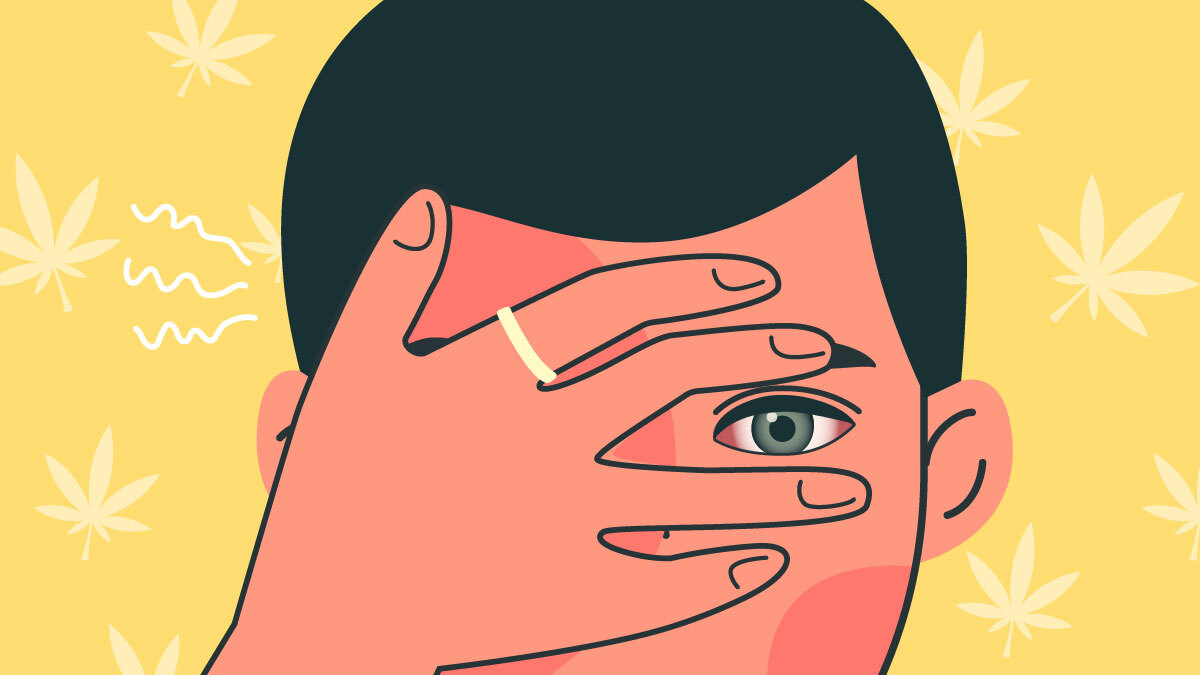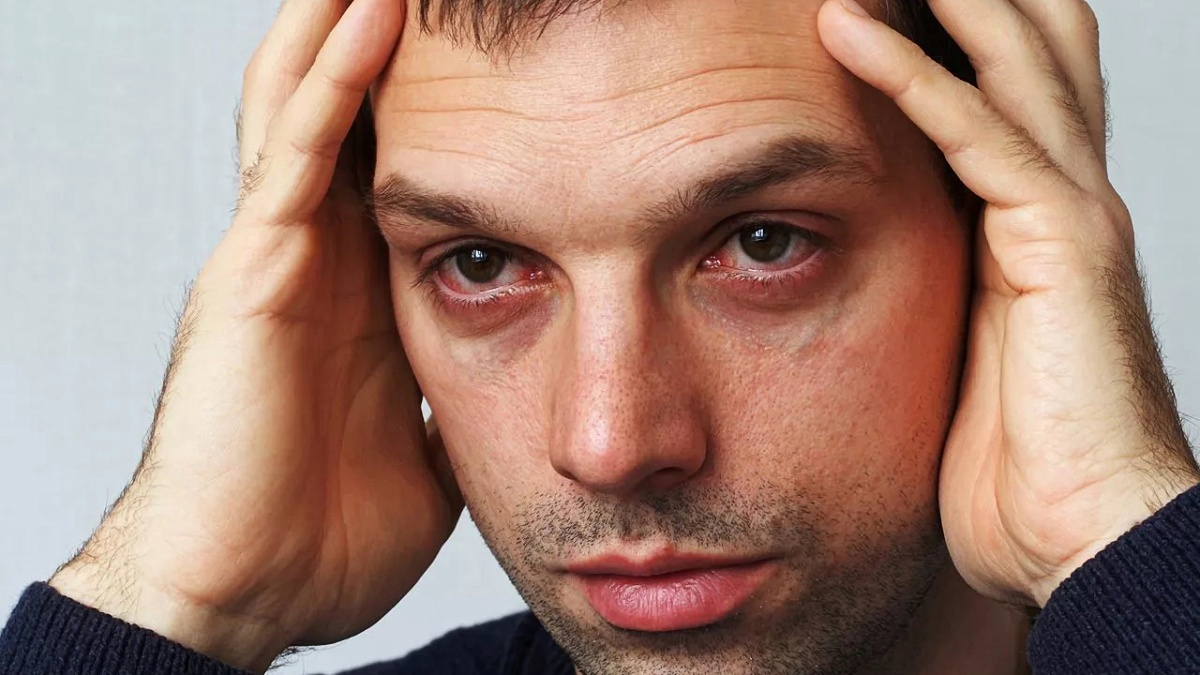Why Does Smoking Weed Make Your Eyes Red?

When you were younger, there’s a good chance you rushed through the front door and ran straight to your room after a night spent with friends. Most of us did that; after all, you didn’t want your parents to see your bloodshot eyes.
Now that you’re older, you may carry a bottle of Visine in your purse or pocket when you head to work or go out for the day. After all, you don’t want to broadcast the fact that you’ve just smoked up.
It’s not guaranteed that you’ll have red eyes after a smoke sesh. Some people don’t. It’s also quite possible to be left with bloodshot eyes simply after enjoying an edible, although that’s not always a given, either.
What’s the deal with those red eyes? Why don’t cigarette smokers get them? And how can edibles trigger the same problem, if there’s no smoke to irritate your eyes?
You’ve probably already guessed the answer to those questions. The cause of bloodshot eyes isn’t the smoke, it’s the weed. Actually, it’s the THC in weed.
How THC Affects the Body
We probably don’t have to specify the most obvious effect of psychoactive THC in marijuana: it makes you high. In order to understand the “red eye” phenomenon that often follows, however, we first have to discuss how THC interacts with the body.
THC’s molecular structure makes it very similar to some of the neurotransmitters that carry messages throughout the body and brain. That similarity allows THC molecules to interact with the body’s cannabinoid receptors, important parts of the endocannabinoid system (ECS) that normally transmit messages through the nervous system. When THC activates those receptors, it alters the way that the brain operates while you’re under the influence of weed. Pot is called a “mind-altering drug” for a good reason.
The areas of the brain that are affected the most include its pleasure and reward centers. That’s why getting blazed is usually so enjoyable.
But the THC in cannabis also causes many metabolic changes when it attaches to endocannabinoid receptors throughout the body. One important effect that THC has is on the smoker’s blood pressure. Let’s talk about that for a moment.
Occasional or new weed users often experience a brief increase in their blood pressure, but after a few minutes, it quickly returns to normal.
In experienced users, though, THC usually lowers blood pressure when it attaches to ECS receptors. (Experts aren’t quite sure why.) That causes blood vessels and capillaries to expand, in a process known as vasodilation – and the wider blood vessels allow more blood to flow.
What does that have to do with red eyes?
Why the THC in Weed Can Make Your Eyes Red

When we talk about “the body,” we usually think about areas below the neck.
However, the eyes are also part of the body, and there are endocannabinoid receptors in and around the eyes.
You probably see where this is heading. It isn’t just blood vessels and capillaries in the heart or extremities that expand when you use weed. THC attaches to cannabinoid receptors in the eyes as well. So when blood begins to flow more freely throughout the body, there’s an influx of blood to the eyes, too.
More specifically, blood flow increases through the ocular capillaries, which are right behind the whites of the eyes (what doctors call the sclera). You don’t feel it happen when you’re smoking, but everyone around you can see the effect; increased blood flow behind the sclera makes your eyes look bloodshot.
And that’s why the THC in weed often makes your eyes look red.
You probably know from experience that the bloodshot eyes don’t last, and you probably have assumed that the effect doesn’t cause any lasting damage or health risks. You’re right on both counts. The red eyes that follow smoking may cause some temporary interpersonal issues with parents or bosses, but they’re nothing to worry about. In fact, the decrease in ocular blood pressure that causes red eyes is the benefit that glaucoma patients receive from cannabis use.
Another question may still be baffling you: why do new or occasional users sometimes experience bloodshot eyes after smoking if their blood pressure is likely to go up instead of down?
There’s a simple answer. Remember that the increase in blood pressure in newbies only lasts for a few minutes. After that, it goes back down – and that decrease in pressure causes their ocular capillaries to expand. Blood flow returns and their eyes may get red.
One more question: why doesn’t it happen to everyone?
Why Some Peoples’ Eyes Don’t Get Red When They Use Weed
We’ve already ruled out the possibility that weed smoke is the culprit. It’s THC, not smoke or vapor, that causes red eyes. Those who consume edibles or drop tincture under their tongue can wind up with bloodshot eyes as well. There has to be another explanation.
There is.
The amount of THC a user consumes largely determines how powerful the effects of weed will be. In most cases, high-THC strains will get you more stoned than low-THC ones. They’ll also have more of an effect throughout the body. That means blood pressure usually drops lower when you consume weed with high THC content – and your eyes are more likely to become red.
Other factors can also determine whether your eyes become bloodshot after marijuana use. Those with high THC tolerance due to heavy use or genetics may not experience a drop in blood pressure. And those who already have high blood pressure would have to use an awful lot of weed for their pressure to drop low enough to cause bloodshot eyes. (And a few people are simply allergic to marijuana.)
For everyone else, there’s one final question.
Can You Prevent Getting Red Eyes After Using Weed?
Needless to say, you can stop using marijuana. Assuming that option’s not on the table, the best approach is to choose strains that have low THC content. Of course, they probably won’t get you as high as you’d like, but your eyes won’t get bloodshot. (You can also limit yourself to nighttime smoking, so the red eyes are gone by the time you have to go out the next day.)
Otherwise, your best bet is to minimize the length of time your eyes stay red. Caffeine is an effective vasoconstrictor, inducing blood vessels and capillaries to contract and restricting blood flow through the body. A few cups of coffee or some chocolate will turn your red eyes white faster than just going to sleep.
In a hurry? Coldwater is also a vasoconstrictor; taking an ice-cold shower will divert blood to the body’s core, and away from the eyes and head. A more palatable alternative: put an ice pack over your eyes. They won’t lose their bloodshot appearance right away, but it will speed the process.
Or you could just consider the red eyes you get from weed to be a stoner badge of honor, and wear them proudly.
Why Does Weed Make Your Eyes Red: FAQ
Q: How long do eyes usually stay red after smoking weed?
A: The bloodshot look can last as long as 8-12 hours if you have a very low tolerance to THC and have smoked very potent weed. In most cases, the effect will wear off in 3-4 hours, often sooner.
Q: Is there a difference in red eyes between people who smoke and those who eat edibles?
A: Yes. If you’ve tried edibles, you know that the THC takes longer to kick in; it first has to be digested in the stomach before the kidneys can send it on through the bloodstream. Edibles’ effects also last longer and are usually stronger. That means red-eyes won’t appear for at least an hour or two after consumption and can last as long as 12 hours.
Reference:
Zou, S., & Kumar, U. (2018). Cannabinoid receptors and the endocannabinoid system: signaling and function in the central nervous system. International journal of molecular sciences, 19(3), 833. [1]
Abuhasira, R., Haviv, Y. S., Leiba, M., Leiba, A., Ryvo, L., & Novack, V. (2021). Cannabis is associated with blood pressure reduction in older adults–A 24-hours ambulatory blood pressure monitoring study. European Journal of Internal Medicine, 86, 79-85. [2]
Yazulla, S. (2008). Endocannabinoids in the retina: from marijuana to neuroprotection. Progress in retinal and eye research, 27(5), 501-526. [3]
Echeverri, D., Montes, F. R., Cabrera, M., Galán, A., & Prieto, A. (2010). Caffeine’s vascular mechanisms of action. International journal of vascular medicine, 2010.[4]